Feb 13, 2022 | coins, Euro, news

The controversial Croatian 1 Euro coin with the marten design (Image courtesy of the Croatian National Bank)
Although Croatia became a member of the European Union in 2013, the country that used to be part of Yugoslavia became eligible to become a member of the European Exchange Rate Mechanism (ERM) II and must convert to the euro by January 1, 2023.
Croatia is getting ready by updating its minting processes to produce euro coins. The process includes a nationwide contest to create new designs for the side of the euro coins they can customize.
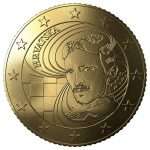
Croatia 50 euro cent design featuring Nikola Tesla (Image courtesy of the Croatian National Bank)
This past week, Croatia introduced the design of the 1 euro coin featuring an image of a Pine Marten that may have been copied from a photograph. The marten is a weasel-like animal that lives in many northern climates, including the two species that live in North America. Its prevalence in Croatia led to its selection during the design competition.
However, it appears that the marten image is a “copy” of a photograph by Scottish photographer Iain H. Leach. Leach was told about the design by others who claimed plagiarism. One user on Twitter posted a video comparing the two images by overlapping the designs.
Play the following clip and you decide.
According to one report, a search for “side view marten” will return Leach’s image as one of the first few results fueling the plagiarism charges. Since Google searches use many customizing factors, the only way to force a search to return Leach’s image was to search for “side view marten leach.”
If the artist copied Leach’s photograph, the design would violate his copyright. The Croatian National Bank decided to not use the design.
And now the news…

February 7, 2022
Six treasure finds dating from the Bronze Age to post-medieval periods were declared treasure on Friday by John Gittins coroner for North Wales east and central. The objects were all discovered by metal detectorists and include a Bronze Age hoard, three medieval coin groups, a post-medieval bodkin and seal matrix.

→ Read more at
wrexham.com

February 7, 2022
It is time to retire the penny from circulation. All of them. In this expensive modern age we no longer have a need for something as worthless as a penny. They are expensive to mint, a waste of time for everyone using them, bad at being money and get less valuable every single year. I hope by the end of this column you will be, at the very least, sympathetic to the idea of letting the penny go and relinquishing it to history books and coin collections.

→ Read more at
uiargonaut.com

February 8, 2022
The extremely rare Edward VIII penny was never even officially released (Image: Showpiece.com/PA Wire) A rare coin marking the reign of King Edward VIII has been valued at a whopping £200,000.

→ Read more at
mylondon.news

February 8, 2022
The euro has not even been introduced in Croatia yet, but the single currency is already causing the second scandal.

→ Read more at
netherlandsnewslive.com
Jan 29, 2019 | coins, education, Euro, foreign
After my last post about the Staatliche Münze Berlin, the Berlin State Mint, a few German readers provided a lesson in the political structure of Germany to understand the institution’s role in the country’s coin production.
Unlike what I wrote previously, the Berlin State Mint is a government mint but for the government of the Federal State of Berlin.
Berlin is one of two cities that is also designated as a state. The other is Hamburg. The divisions trace back to the many small states that existed in the region during the days Holy Roman Empire. In short, it was an attempt to bring unification to the region by attempting to allow each smaller states, kingdoms, principalities, cities, etc. to provide their own rule for the common good. Some reference suggests that there were over 300 individual governments with their own governing rules at the height of the Empire.
Arguments, wars, and Napolean brought about many changes where many of the smaller states merged into larger ones and others changed by conflict. Following the Treaty of Versailles that ended World War I, Germany was forced to give up territories that left the current state boundaries were mostly set as they are today.
Before I hear from our German friends, I am leaving out a lot of history on purpose. I just want enough to bring context to the discussion. If anyone wants a more detailed discussion about the history as it pertains to the German mints, I recommend reading the article “
Why Germany has Five State-Owned Mints.”
Although the Third Reich tried to unify the country around a federal government, there were a number of administrative functions left to the states including the minting of coins and printing of currency. Even Adolph Hitler learned that to keep his version of an orderly government, he had to work with each of the states.
Following World War II, the concept of the confederation of states continued with the formation of the Federal Republic of Germany (West Germany) and the German Democratic Republic (East Germany). Although the federal government has evolved with more central power, the states continue to have a degree of independence in their operations that a person with a background in United States history would consider a confederation.
As the country evolved and times mandated change, many of the mints were closed. Production consolidated with the changes in the political structure of Germany. Following the unification of Germany in 1990, only five state mints remained:
NOTE: First letter on the line is the mintmark associated with the mint.
-

-
Berlin State Mint
-

-
State Mint of Baden-Wuerttemberg, Munich
-

-
Barvarian Main Mint, Stuggart
-

-
State Mint Baden-Wuerttemberg, Karlsruhe
-

-
Hamburg Mint
When the euro was introduced, German law mandated that the minting of the euro coins would be distributed evenly among the five mints. Any production beyond the federally mandated requirement to produce the euro is between the mint and the Finance Minister of the state.
As for the currywurst coin, although it is produced by the Berlin State Mint, it is a product of that mint and not a product endorsed by the German federal government.
If you are confused you are in good company. Even after spending parts of three days looking into the history, I am not sure I am right. It is more confusing than the structure behind the U.S. Mint!
Images of the Germany state mints are courtesy of the mints via their websites.
May 18, 2016 | currency, Euro, news

Euro 7+3 Series €500 Banknote
The Europa series is the second designed series of banknotes that will include updated security features and updated designs. ECB has been working on a phase in of the Europa series since 2013 beginning with an education program followed by the issuance of the €5.00 in 2014, €10.00 in 2015, and €20.00 this year.
Although not mentioned in the press release issued by the ECB, it is likely the result of an article by former Treasury Secretary Lawrence Summers who quoted an academic research paper noting how the United States $100 Federal Reserve Note and the €500 banknote have become favorites of criminal enterprises in order to carry out cash-based transaction. In fact, the report noted that criminals have nicknamed the €500 banknote the “Bin Laden.”
Experts interviewed by The Wall Street Journal expressed their doubt that this will do anything to stop crime. While the experts think it is unlikely, there is
an aspect of the analysis that the academics are not thinking about. These academics appear to be also in favor of eliminating physical currency which does
not consider the nature of a legitimate cash economy.
The ECB will not demonetize their first series of banknotes that will allow the current supply of 500e notes to continue to freely circulate.
New Europa Series Banknotes
-

-
Europa Series €5 Banknote Front
-

-
Europa Series €5 Banknote Back
-

-
Europa Series €10 Banknote Front
-

-
Europa Series €10 Banknote Back
-

-
Europa Series €20 Banknote Front
-

-
Europa Series €20 Banknote Back
Images courtesy of the European Central Bank.
Dec 27, 2012 | base metals, BEP, bicentennial, bullion, coins, commemorative, copper, currency, dollar, Euro, Federal Reserve, First Spouse, gold, halves, legislative, nclt, news, nickels, policy, silver, US Mint
We end numismatic 2012 almost the same way as we began, discussing what to do about the one-dollar coins. The over production lead to a quite a number of bills introduced in congress to try to fix the perceived problem but none ever made it to a hearing, let alone out of a hearing. Rather, the U.S. Mint hired Current Technologies Corp. (CTC) to perform an alternative metals study required by congress.

When the U.S. Mint finally published the report and a summary they made a recommendation to study the problems further because they could not find suitable alternatives to the current alloys used. While reading the summary gives the impression that the request is reasonable, the full 400-page report describes the extensive testing and analysis that the U.S. Mint and CTC performed leaving the reader curious as to why they were unable to come to some sort of conclusion—except that there is no “perfect” solution. This is a story that will continue into 2013 and be on the agenda for the 113th congress when it is seated on January 3, 2013.
The other part of the discussion is whether or not to end the production of the one-dollar Federal Reserve Note. It was the last hearing before the House Financial Services subcommittee on Domestic Monetary Policy and Technology for Rep. Ron Paul (R-TX) and the 112th congress that will certainly carry over into 2013.
This does not mean the Bureau of Engraving and Printing is without its controversy. In order to comply with the court order as part of American Council for the Blind v. Paulson (No. 07-5063; D.C. Cir. May 20, 2008 [PDF]) and the subsequent injunction (No. 02-0864 (JR); D.C. Cir. October 3, 2008 [PDF]), the BEP has been working to provide “Meaningful Access” to United States currency.
Secretary of the Treasury Timothy F. Geithner approved the methods that will be used to assist the blind and visually impaired to U.S. currency on May 31, 2011. In addition to examining tactile features, high contrast printing, and currency readers, the BEP issued a Request for Information for additional information to implement their plan. The BEP will be participating at stakeholder organization meetings to socialize and refine their plans. There will probably be few announcements before the conventions of the National Federation of the Blind and American Council of the Blind this summer.

Another building controversy from the BEP is whether the redesigned $100 notes will find its way into circulation. Introduced in April 2010, full production has been delayed because of folding during the printing process. The situation has to be so severe that the BEP has not announced a new release date and delayed releasing the 2011 CFO Report [PDF] to the end of Fiscal Year 2012 while finding a way to bury the scope and costs of the delays. Will the redesigned $100 Federal Reserve Note be issued in 2013? Stay tuned!
Staying with currency issues, there should be a new series of notes when a new Secretary of the Treasury is appointed. It is known that the current Secretary Timothy F. Geithner wants to pursue other options. If the BEP follows its past practice, notes with the new Secretary of the Treasury’s signature would be Series 2009A notes. There have been no reports as to whether Treasurer Rosie Rios will continue in her position.
As for other products, the BEP will continue to issue specially packaged notes using serial numbers that are either lucky numbers (i.e., “777”) or ones that begin with “2013” as part of their premium products. Of course they will continue to issue their sets of uncut currency.
Another carry over from 2012 will be whether the U.S. Mint will issue palladium coins that were authorized by the American Eagle Palladium Bullion Coin Act of 2010 (Public Law No: 111-303 [Text] [PDF]). The law requires that the U.S. Mint study of the viability of issuing palladium bullion coins under the Act. That report was due to congress on December 14, 2012 but has not been made public at this time.

Bibiana Boerio was nominated to be the Director of the U.S. Mint.
Other than the higher prices for silver products, the U.S. Mint should not generate controversies for its 2013 coin offerings. There will be no changes for the cent, nickel, dime, and half dollar with the half dollar only being struck for collectors since it has not been needed for circulation since 2002. These coins will be seen in uncirculated and proof sets with silver versions for the silver sets.
For the sets with the changing designs, the reverse of the 2013 America the Beautiful Quarters Program will honor:
There has been no confirmation from the U.S. Mint whether they will strike San Francisco “S” Mint quarters for the collector community as they did in 2012.
The 2013 Presidential $1 Coins ends the 19th century and begins the 20th century with some of the more interesting Presidents of the United States in history:
If we honor the Presidents we have to honor their spouses. In 2013, the First Spouse Gold Coins will honor:
- Ida McKinley
- Edith Roosevelt
- Helen Taft
- Ellen Wilson (died 1914)
- Edith Wilson (married Woodrow Wilson 1915)
The U.S. Mint has not released designs for these coins at the time of this writing.

2013 Native American Dollar Reverse Design
Congress has authorized two commemorative coin programs for 2013:
American Eagle coin programs will continue with the bullion, collector uncirculated, and proof coins for both the silver and gold. The American Eagle Platinum bullion coin will continue to use its regular reverse while the American Eagle Platinum Proof will continue with the Preamble Series. The Preamble Series is a six year program to commemorate the core concepts of the American democracy as outline in the preamble of the U.S. constitution. For 2013, the reverse will be emblematic of the principle “To Promote the General Welfare.” The U.S. Mint has not issued a design at this time.
Currently, there are no announced special products or sets using American Eagle coins and no announced plan for special strikings such as reverse proofs or “S” mint marks.
Finally, we cannot forget the American Buffalo 24-Karat Gold Coins that will be available as an uncirculated coin for the bullion/investor market and a proof coin for collectors.
And I bet you thought that 2013 would be a mundane numismatic year!
Nov 23, 2012 | cents, coins, Euro, foreign, fun

A 2012 one Euro cent pocket change find from France next to a 2012 Lincoln cent.
After doing an online search, I found that this is a 2012 coin from France.
As with all Euro coins, the reverse or common side depicts the same common Euro cent design that every country in the European Union uses and has used since Euro coins and currency were issued in 2002.

Le Triomphe de la République by sculptor Aimé-Jules Dalou at Place de la Nation in Paris features Marianne, the national emblem of France.
To the right of Marianne are the letters “R” and “F” for the République Française (French Republic). The design is surrounded by 12 stars symbolizing the the 12 nations in the European Union at the time of the design. It was designed by Fabienne Courtiade, an engraver from Monnaie de Paris (Paris Mint) whose name appears as “F COURTIADE” between the fourth and fifth star (assuming clock-like positions). This design is used on France’s one, two, and five Euro cent coins—all copper-plated steel coins.
If nothing else, I am a little ahead of the game since the coin is worth 1.3-cents at the current exchange rate. I hope you had a good Thanksgiving.
Image of the statue “The Triumph of the Republic” courtesy of Wikimedia Commons.
Aug 20, 2011 | coins, Euro, video
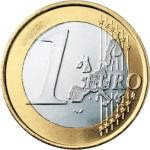 One of the reason I collect coins and write this blog is that I find coins interesting, regardless of whether they are modern or otherwise. I do not have to collect a particular coin type to be fascinated by them. Although I do not collect Euro coins, I am fascinated by the bi-metallic 1 and 2 Euro coins.
One of the reason I collect coins and write this blog is that I find coins interesting, regardless of whether they are modern or otherwise. I do not have to collect a particular coin type to be fascinated by them. Although I do not collect Euro coins, I am fascinated by the bi-metallic 1 and 2 Euro coins.
As with all Euro coins, the common reverse side shows its value and depicts a map of Europe representing the entire Eurozone. The obverse has what is called the “national side,” the side each member nation customizes to represent their unique place in the world. Some countries, like Belgium, uses the same design on all of their coins while others use different designs.
While all Euro coins are made of base metals, the 1 and 2 Euro coins are bi-metallic. For the 1 Euro coin, the inner part is made of copper-nickel with a silvery color while the outer part is made of a nickel brass and has a golden-like color. The composition is reversed for the 2 Euro coin.
 The edge of the 1 Euro coin consist of alternating segments, three smooth, three finely ribbed.
The edge of the 1 Euro coin consist of alternating segments, three smooth, three finely ribbed.
 The edge of the 2 Euro coin is finely milled with lettering that varies by nation, the same as the obverse.
The edge of the 2 Euro coin is finely milled with lettering that varies by nation, the same as the obverse.
What I find fascinating is that both metals are made separately but when they are struck, the design overlaps both metals and the striking process fuses the metals together. It was fascinating since I never thought about how the one and two Euro coins were until I came across a video show how the 2 Euro coins are made.
This video is from the National Geographic Channel. I am not sure what show it is from, but it shows how the 2 Euro coin is made:
All images courtesy of Wikimedia.
Jul 7, 2010 | coins, currency, Euro, foreign, gold, RCM, video
Not all coin news comes from the United States. Here are three interesting non-U.S. stories from the last few weeks:
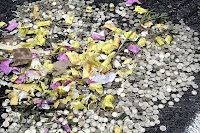 Foggia, Italy—A truck in southern Italy carrying €2 million in one and two euro coins crashed and spilled its load on the highway. Feeling they hit the jackpot, drivers stopped and started to scoop up the coins. On the scene, it was estimated that €10,000 was taken. A later count upped that estimate to €50,000. No arrests were reported.
Foggia, Italy—A truck in southern Italy carrying €2 million in one and two euro coins crashed and spilled its load on the highway. Feeling they hit the jackpot, drivers stopped and started to scoop up the coins. On the scene, it was estimated that €10,000 was taken. A later count upped that estimate to €50,000. No arrests were reported.
Driver of the truck and the two cars in the accident were not seriously injured, but they were not the focus of many of the stories. With coins strewn on the roadway and the median, the company responsible for the transport of the coins will be spending the next few days trying to sweep up the coins that motorists did not take.
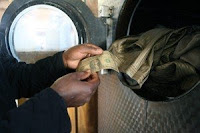 Zimbabwe—In a country where runaway inflation caused their currency to become worthless and the government made U.S. currency legal tender, Zimbabweans are washing their U.S. dollars so that they can be used.
Zimbabwe—In a country where runaway inflation caused their currency to become worthless and the government made U.S. currency legal tender, Zimbabweans are washing their U.S. dollars so that they can be used.
In this poor country, low-denomination U.S notes are used until they fall apart. But in order to protect currency in crime-ridden areas, notes are carried in shoes or underwear. The obvious sanitary and malodorous issues has made it a problem causing banks and many merchants to refuse to take currency that is dirty and smelly. Some people gently hand-wash their notes and some laundry services have discovered that they can wash notes in the gentle cycle then hang the notes to dry.
Apparently this works for the poor in Zimbabwe since the notes outlive the Bureau of Engraving and Printing’s estimated life span of a $1 Federal Reserve Note of 20-months.
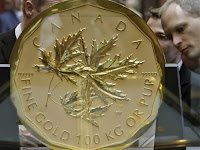 Vienna—Spanish gold dealer Oro Direct S.L.U. bought the world’s largest gold coin at auction for &euro3.27 million (approximately $4.02 million). The 100 kilogram coin with a face value of C$1 million was made by the Royal Canadian Mint in 2007. This coin currently holds the world’s record for being the largest coin ever made.
Vienna—Spanish gold dealer Oro Direct S.L.U. bought the world’s largest gold coin at auction for &euro3.27 million (approximately $4.02 million). The 100 kilogram coin with a face value of C$1 million was made by the Royal Canadian Mint in 2007. This coin currently holds the world’s record for being the largest coin ever made.
Gold was trading at $1,253.55 per troy ounce in London at the time of the auction.
“We believe that this is a way to demonstrate our opinion that gold is the ultimate store of wealth,” Oro Direct spokesman Michael Berger was reported as saying. “As long as central banks continue to print enormous amounts of paper money, we believe physical gold will be a fantastic investment.”
The following news video is from Reuters:
About the coin in a video by the Royal Canadian Mint:
Images from Italy and Zimbabwe are courtesy of the AP.
Image of the C$1 Million Maple Leaf courtesy of Reuters.
May 22, 2010 | coins, economy, Euro
You might have noticed that a European debt crisis has caused the markets to panic where some have been saying there is no relief in sight. It started wit the economy of Greece needing its own bailout while it is questioned as to whether they can pay the money back. The the news that Portugal, Spain, and possibly Ireland may follow. As a result, the Euro is at a 4-year low against the dollar and dropping.
Aside from the economic impact, there has been questions about the viability of the European Union as an economic entity and its ability to act as a central bank in the best interests of the sovereign members of the Euro zone. Countries can no longer manipulated their currencies or manufactured more money to maintain solvency. They now have to follow the rules of the European Central Bank in order to maintain “fairness” within the Euro zone.
What would happen if these countries did not want to be beholden to the European Central Bank? Countries would have to break from the bank and issue its own currency. There has even been speculation as to the current value of the former EU currencies if they were still in circulation.
For numismatists it would add new collectibles to the market. Countries that would re-issue its own currencies would likely demonetize the Euro and force locals to trade in their Euro coins and notes for the re-issued currency. This would make the reverse designs that are country specific instantly collectible as well as the new Drachma, Escudo, Pesta, Franc, Lira, or Deutsche Mark that would be issued in its place.
Maybe Great Britain was right for not converting to the Euro. But for now, their newly issued circulating coinage is arguably the most interesting in the Euro zone. Maybe another country will join them an open new areas of collectibles.

 → Read more at wrexham.com
→ Read more at wrexham.com
 → Read more at uiargonaut.com
→ Read more at uiargonaut.com
 → Read more at mylondon.news
→ Read more at mylondon.news
 → Read more at netherlandsnewslive.com
→ Read more at netherlandsnewslive.com


























